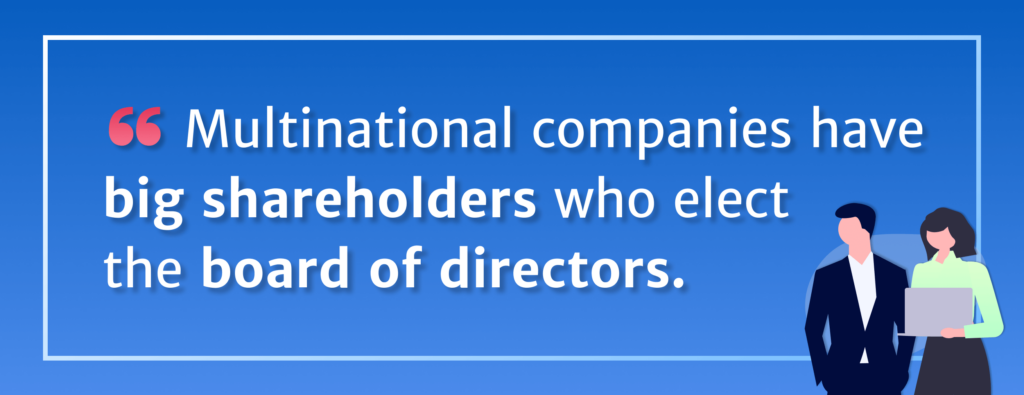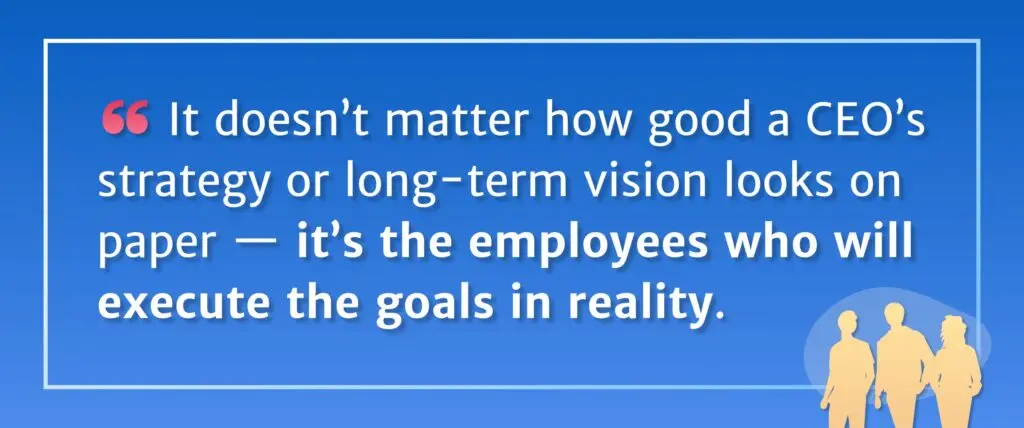Explained Simply: The Organizational Structure of a Multinational Company
Blog Categories:
Published:
February 14, 2024
Reading Time:
7 minutes

Have you ever wondered who holds the true power within a corporation? Most people would think it’s the CEO. But did you know that above the CEO lies a group of strategic masterminds known as the board of directors?
In this article, we’ll delve into the intricate hierarchy of corporate leadership, exploring the roles of the board, the C-suite executives, senior management, and beyond. If you’re a business leader who wants to structure your organization for success or someone who wants to climb the corporate ladder, then this article is for you.
So, let’s dive into it.

In this article, we’ll delve into the intricate hierarchy of corporate leadership, exploring the roles of the board, the C-suite executives, senior management, and beyond. If you’re a business leader who wants to structure your organization for success or someone who wants to climb the corporate ladder, then this article is for you.
So, let’s dive into it.

KEY TAKEAWAYS
- The board of directors holds the highest authority in a corporation, responsible for strategic decision-making and overseeing executive management.
- Next in line is the C-suite, with the CEO at the top. Other professionals at this level include the CFO (Chief Financial Officer), COO (Chief Operating Officer), and CMO (Chief Marketing Officer).
- Presidents and vice presidents form the senior management tier and oversee organizational strategy and specific functional areas.
- Directors, regional managers, and divisional managers are part of the middle management.
1. Board of Directors
Contrary to popular belief, the CEO is not at the top of the corporate hierarchy. This is because above the CEO lies the board of directors. They are the strategic masterminds behind the scenes who plot the course of the organization and make the big decisions. Their primary responsibilities include setting the company's strategic direction, making major policy decisions, and appointing and overseeing the executive management, including the CEO.
Now you may be wondering, “If the board of directors appoints the CEO, who appoints the board of directors?” Well, multinational companies have big shareholders who elect the board of directors. Shareholders are the individuals or entities that own shares or stocks in the company. The process of appointing the board usually involves shareholders voting during the company's annual general meeting (AGM) or a meeting specifically organized for voting.

Ultimately, the board of directors is accountable to the shareholders. In the corporate world, the election process is a fundamental aspect of governance as it ensures that those entrusted with making key decisions on behalf of the company have the confidence and support of the shareholders.


Apart from the aforementioned, some other roles at this level include social media managers, customer experience analysts, marketing managers, HR specialists, engineers, product managers, financial analysts, etc.
Now you may be wondering, “If the board of directors appoints the CEO, who appoints the board of directors?” Well, multinational companies have big shareholders who elect the board of directors. Shareholders are the individuals or entities that own shares or stocks in the company. The process of appointing the board usually involves shareholders voting during the company's annual general meeting (AGM) or a meeting specifically organized for voting.

Ultimately, the board of directors is accountable to the shareholders. In the corporate world, the election process is a fundamental aspect of governance as it ensures that those entrusted with making key decisions on behalf of the company have the confidence and support of the shareholders.
2. C-Suite
The executive leadership team, often referred to as the “C-suite”, consists of top executives responsible for key areas of a company's operations. After the board of directors, this is the group that has the bulk of decision-making power and responsibilities. Let’s understand each role in the top leadership team briefly.CEO (Chief Executive Officer) / President
Working closely with the board of directors, the CEO is the top executive responsible for the overall leadership and direction of the company. Oh yes, they also represent the organization externally. For instance, in a recent senate hearing, Mark Zuckerberg, CEO of Meta, represented the company.CFO (Chief Financial Officer)
Cash flow is king in business. So, a CFO is in charge of the company's financial strategy and management. They oversee financial planning, budgeting, accounting, and reporting while also playing a critical role in ensuring the company's financial health.COO (Chief Operating Officer)
The COO focuses on the day-to-day operations of the company. They are responsible for optimizing business processes, improving efficiency, and ensuring that the company's operations align with its strategic goals.CMO (Chief Marketing Officer)
A famous French playwright Milan Kundera said, “Business has only two functions—marketing and innovation.” That’s why companies have a C-suite executive who is responsible for developing and implementing the company's marketing and communication strategies. Furthermore, a CMO also oversees branding, advertising, public relations, and market research.
3. Senior Management
At this level of the leadership structure are presidents and vice presidents (VPs). These are the individuals who bear significant responsibilities in shaping the strategic direction and daily operations of the company. First, there are presidents who oversee the entire organization's management and strategy. Vice presidents (VPs), on the other hand, are senior executives leading specific departments or functions within the company. But remember, both presidents and vice presidents generally report to the CEO or other C-suite member. Let’s understand this in detail.Presidents
- Regional President: Oversees operations, strategy, and performance in a specific geographic region and adapts global strategies to local conditions for regional success.
- Functional President: Manages a specific business aspect (e.g., sales, marketing) on a broader scale to ensure the function's success across regions or business units.
- President of International Operations: Coordinates global strategies and addresses challenges and opportunities in international markets for effective execution.
Vice presidents (VPs)
- VP of Finance: Manages financial aspects, including budgeting and reporting, collaborating to align financial goals with overall business objectives.
- VP of Sales: Leads the sales team and develops strategies to achieve revenue targets and drive the company's growth.
- VP of Marketing: Develops and executes marketing strategies and oversees branding, advertising, and market research.
- VP of Operations: Manages day-to-day activities and optimizes processes and resources for increased efficiency and productivity.
4. Middle Management
When it comes to translating the company's overarching strategies into actionable plans at the operational level, middle management plays a very important role. Let’s understand how they work their magic.Directors
Directors are key figures in middle management and they act as liaisons between top management and lower-level employees. This ensures the implementation of strategic goals at the functional level, which is essential. Why? Well, it doesn’t matter how good a CEO’s strategy or long-term vision looks on paper—it’s the employees who will execute the goals in reality. That’s why directors have to collaborate with other directors and senior leaders to align their functions with the company's broader objectives.
Regional managers
You see, multinational companies are spread across many geographic regions. So, regional managers hold a pivotal role in coordinating and optimizing operations within every specific region. They foster a strong regional presence by addressing unique market conditions and cultivating relationships with local stakeholders. This is something that the board of directors or C-suite cannot manage themselves.Divisional managers
Multinational companies generally have many divisions working toward various business objectives. This is when divisional managers come into the picture. They lead teams, set divisional objectives, and collaborate with other departments to ensure a cohesive approach to achieving organizational goals. Divisional managers can lead various divisions within a company, depending on the organization's structure and industry. For example, they could lead the research and development division, legal division, operations division, etc.5. Team Leaders
And now, let’s talk about the people who do the heavy lifting for any business. Team leaders and individual contributors are professionals who play vital roles in driving the company's operations, innovation, and growth. Let’s understand their role in detail.Team leads
Team Leads are experienced professionals who are responsible for guiding and supervising a team of individuals working on specific projects or tasks. They provide direction, support, and mentorship to ensure the team's success and alignment with organizational goals.Project managers
Well, this is an obvious one. Project managers oversee the planning, execution, and completion of projects within defined timelines and budgets. Furthermore, they coordinate resources, set objectives, monitor progress, and communicate with stakeholders to ensure project success.Business development managers
Business development managers are responsible for identifying new business opportunities, expanding market reach, and establishing partnerships to drive revenue growth. Their duties include conducting market research, negotiating deals, and developing strategies to capitalize on emerging trends and market dynamics.Sales managers
Did somebody say “money”? Well, that’s what you hear when you hire competent sales managers. These professionals lead sales teams responsible for generating revenue through the sale of products or services to clients or customers. They develop sales strategies, set targets, cultivate client relationships, negotiate contracts, and oversee the execution of sales plans to achieve revenue goals and drive business growth.Apart from the aforementioned, some other roles at this level include social media managers, customer experience analysts, marketing managers, HR specialists, engineers, product managers, financial analysts, etc.
How Organizational Consultants Can Help
Now that you know how multinational companies design their organizational structure, allow us to introduce you to Consultport’s organization consultants. With over 10,000 top-tier, experienced consultants in our network, we’re the world’s leading online consulting platform. Here’s what our seasoned organization consultants can do for you:
If you’re ready to shake up things in your organization and transform its structure, get in touch with us now.
- Business transformation consultants: Let our experts drive multiple initiatives to adapt your company to the constantly changing business environment to ensure resilience and competitiveness.
- Organizational design consultants: Seeking to optimize your organizational structure? Assess your organizational structure and optimize it for efficiency and effectiveness with our experienced consultants.
- People development consultants: Investing in your people is investing in your company's future. Advance within your company with the expertise of our seasoned consultants who can guide personal and professional growth.
- Agile transformation consultants: Embracing agility is key to staying ahead of the curve. Transform and skyrocket your organization’s growth with our Agile transformation consultants who can help you enable rapid adaptation and innovation.
If you’re ready to shake up things in your organization and transform its structure, get in touch with us now.
Share This Story, Choose Your Platform!



